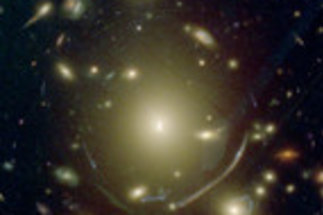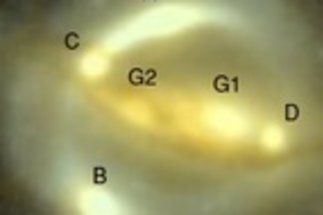Research News Archive
2014
October: A new neutrino-emission asymmetry in forming neutron stars
September: Detailed gravitational lens modelling of the galaxy cluster MACS J1149.5+2223
August: X-ray diagnostics of the donor star in ultra-compact X-ray binaries
July: New light on the origin of the Galactic ridge X-ray emission
June: Stellar halos reveal galactic accretion: Big fish eat small fish
May: Resolving the radio sky
April: A New analytical model for turbulence pressure in galaxy clusters
March: An observational and theoretical view of the atomic gas distribution in galaxies
February: Connecting the formation of monster black holes to streaming motions in the early Universe
January: Superfluid Effects in Neutron Star Oscillations
2013
December: D³PO: Denoising, Deconvolving, and Decomposing Photon Observations
November: Why do the most massive galaxies in the local Universe stand still?
October: Planck maps of the cosmic microwave background test the fundamental symmetry of space-time during cosmic inflation
September: Metals in galaxies: Is what we see what we expect?
August: Searching for Type Ia Supernovae Progenitors through Circumstellar Material
July: Hunting for hints on galaxy formation in stellar spectra
June: A New Gauge of the Origin of Type Ia Supernovae: Searching for He II Recombination Lines in Elliptical Galaxies
May: The Bluedisk project: searching for clues about how disk galaxies form
April: The Fine Art of Cooking an Exquisite Stellar Banquet
March: Stellar lithium abundances support standard Big Bang scenario
February: Asteroseismology of magnetars
January: Distances in the Galaxy: where are those metal-poor stars?
2012
December: A nova origin of the gas cloud at the Galactic Center?
November: First Light for the Millennium Run Observatory
October: Smashing white dwarfs: explaining the brightness of cosmic explosions
September: Trojan horses within molecular clouds: How do a few massive stars determine the fate of a whole galaxy?
August: Lyman Alpha Emitters around the Epoch of Reionization: Tip of the Iceberg
July: Cosmic Warming by the First Quasars: Did the earliest supermassive black holes slow the growth of the rest?
June: Chemical composition of old, metal-poor stars poses new questions
May: What makes a galaxy a disk or a spheroid?
April: Gas in Galaxies at the End of their Lives - Food for New Stars
March: Infrared Beacons in the Universe - Red Supergiant Stars and the Chemical Composition of Galaxies
February: Cosmic Vibrations from Neutron Stars
January: SDSS-III finds a large population of massive galaxies still alive eight billion years after the Big Bang
2011
December: Black hole pairs: shrinking, stretching and flipping
November: Music of stars reveals their properties
October: Cold gas and star formation in galaxies
September: The Millennium-XXL Project: Simulating the Galaxy Population in Dark Energy Universes
August: Curious, these inflated hot Jupiters ...
July: Faraday caustics: Light patterns from cosmic magnetism
June: Present-day cosmic elemental abundances from massive stars in the solar neighbourhood
April: New Evidence for inside-out formation of galaxy disks
March: The Odd Spatial Distribution of Radio Galaxies on Cosmic Scales
February: The First Stars in the Universe
January: Data analysis and steam engines
2010
December: Stars and latte macchiato
November: A deep look at the Milky Way in hard X-rays
October: Exploring the history of the Milky Way
September: Solving the mystery of the Sun's low lithium abundance - and its relation to extrasolar planets
August: Magnetic fields in merging neutron stars
July: What is the matter with dwarf galaxies?
June: Are the progenitors of Type Ia supernovae less massive than previously thought?
May: Iron peak elements in metal-poor stars
April: Polarization as a way to measure transverse gas motions in galaxy clusters
March: Imaging the surface of massive stars
February: The GALEX Arecibo SDSS Survey
January: Massive, Dense Nuclei in Young Starbursts: Progenitors of Early Type Galaxy Cusps?
2009
December: Mapping of the Universe beyond the Known
November: Are Neutron Stars Strange?
October: Mapping extragalactic dark matter structures through gamma-rays
September: Supermassive black holes grow in different ways
August: Mathematics of digital senses: Information Field Theory for signal recognition
July: Unveiling the intricate nature of galaxy bulges
June: Quasars in the Early Universe: Smokestacks of the first Cosmic Cities?
May: The shining make-up of our star
April: Jets are magnetic!
March: Using Galaxy Clusters as Distant Mirrors of the Universal Acceleration
February: Dynamical formation of X-ray binaries in the nucleus of Andromeda galaxy.
January: Hyper-velocity star challenges the Galactic Centre scenario
2008
December: Our Galaxy and its stellar halo
November: Solar prominences: the need for dynamical modelling
October: Cosmography
September: The shapes of planetary orbits
August: Galactic wind in the bulge of the Andromeda galaxy
July: What Dark Matter should look like
June: What can the cosmological recombination radiation tell us about the thermal history of the Universe?
May: Measuring invisible pressure with optical and X-ray data
April: Searching for observational evidence of QSO feedback
March: Connecting star formation and black hole accretion with galaxy-galaxy interactions
February: Elemental fingerprints of the oldest stars
January: A close look at solar granulation
2007
December: Numerical sunspots
November: Unusually bright supernovae from asymmetric stellar explosions
October: Summed hard X-ray spectrum of local AGN: a link to the cosmic X-ray background
September: Supplying simulation data to the world
August: Connecting star formation and black hole growth in local galaxies
July: Cosmological hydrogen recombination lines from redshifts z~1400
June: Building up the brightest galaxies of the Universe
May: INTEGRAL probes large scale structure of the local Universe
April: How to produce a burst of gamma-rays
March: How are Brightest Cluster Galaxies different from normal galaxies?
February: New predictions encourage the extragalactic search for gravitational waves from supernovae
January: Resolving the Galactic X-ray background
2006
December: High-fidelity imaging of the cosmic mass distribution
December: The Outer Disks of Galaxies Observed by GALEX
November: Neutron star seismology challenges strange star models
October: Measuring the cosmic hard X-ray background with INTEGRAL
September: Do sunspots affect the Earth's climate?
September: A neutron star-driven X-ray flash associated with SN 2006aj
August: Map of the Galaxy in the 6.7 keV emission line
July: The Supernova that Made the Crab Nebula
June: The stellar populations of nearby galaxies as fossil records of galaxy evolution
May: Starquake reveals hidden structure of a neutron star
April: Hard X-ray glow of the Milky Way is now mapped with INTEGRAL
March: New Map of Milky Way Reveals Millions of Unseen Objects
February: Connecting the physical properties of galaxies with their clustering
January: Feeding the Milky Way Central Black Hole with Stellar Winds
2005
December: The 3-dimensional structure of a sunspot
November: Can Buoyant Bubbles Heat the Cores of Clusters of Galaxies?
October: Short Gamma-Ray Bursts: Death Throes of Merging Neutron Stars
September: A Violation of Cosmological Isotropy?
August: Magnetic Turbulence in the Hearts of Clusters of Galaxies
July: Abundance Stratification in Type Ia Supernovae
May: Annihilation of positrons in the Galaxy
April: The parallel lives of super-massive black holes and their host galaxies
March: Discovery of the binary companion of Tycho Brahe's supernova
February: Colliding galaxies light up dormant black holes
February: Hysteresis in spectral state transitions of accreting black holes
January: Integral rolls back history of Milky Way's super-massive black hole
January: Searching for Fossil Star Streams in Nearby Galaxies
2004
December: Observing reionization with a radio telescope
November: Tramp stars in the intergalactic space within galaxy clusters: records of a violent history
October: Three-dimensional simulations of Type Ia supernova explosions
September: Short Gamma-Ray Bursts -- New Models Shed Light on Enigmatic Explosions
August: Integral discovers unusual kind of gamma-ray burst
August: The largest N-body simulation of the universe
July: Low Mass Black Holes Still Grow Today
June: The outermost stellar haloes of galaxies
May: The chemical evolution of galaxy clusters and of the galaxies within them
April: Looking into the heart of a supernova
March: The magnetic fields of A-stars and white dwarfs explained
February: RXTE 3-20 keV all sky survey, Statistical properties of local AGNs
January: Protons with Horsepowers: On the Traces of the Universe's Highest Energy Particles
2003
December: Can we see the dark matter?
November: Galaxy Clusters when the Universe was Middle Aged
October: Neutron Stars as Cannonballs
September: Glowing in the Cold - New Theory for Mysterious Shining in Clusters of Galaxies
August: A Jet is a Jet, Big or Small: Scale Invariance of Black Hole Jets
July: High-mass X-ray Binaries as a Star Formation Rate Indicator
June: Supernova Simulations Still Defy Explosions
May: Intergalactic Medium Reionization after WMAP Observations
April: Strong X-ray variability of black holes - a puzzle or natural phenomenon?
March: Frozen accretion and spectacular X-ray bursts from the black hole in our Galactic Center
February: Does the black hole in the center of our Galaxy rotate clockwise?
January: The Connection Between Active Galactic Nuclei and Starbursts
2002
December: The Physics of Type Ia Supernova Explosions: A new European Research and Training Network
November: Decrypting high-resolution Galaxy Spectra
October: The cosmic star formation history
September: Scientists from around the world discuss supernovae in Garching
August: Thermonuclear Flames in Type Ia Supernova Explosions - A Microscopic View
July: M87: Viewing the Hole Feeding
June: Galaxy - Dark Matter Connection
May: Cosmic Rays as Messengers from Black Holes
April: Studying Galaxies in the Sloan Digital Sky Survey
March: Intergalactic Weather Station Reports Shock Wave
February: Magnetic fields as cause for gamma-ray bursts
January: An Obscure Ingredient of Galaxy Clusters
2001
December: Strong Flashing light from the black hole in KV UMa
November: Gravitational wave bursts from core collapse supernovae
October: Hot and very hot gas around black holes
September: Lighthouses of the Universe
August: Quasars and the Cosmic Distance Scale
July: Simulating the Local Galaxy Population
June: Unveiling the Gas Distribution in the Early Universe
May: Old stars telling about the Big Bang
April: Gas Disks Surrounding Binary Stars
March: Radio Ghosts in Galaxy Cluster Collisions
February: How do Massive Stars Explode?
January: Unveiling the secrets of the radio source 3C120
2000
December: Supermassive Black Holes Power Galactic Outflows
November: Mixing through shear instabilities
October: Self-interacting dark matter
September: A Unified Model for the Evolution of Galaxies and Active Galactic Nuclei
August: The Microwave Background and the Planck Mission
July: Longterm Evolution of Extragalactic Jets
June: Type Ia Supernova Simulations
May: Historical Supernovae
April: Accretion onto Black Holes
March: Relativistic jets from collapsars and gamma-ray bursts
February: Triggered planet formation in massive protoplanetary discs
January: The convective URCA process in white dwarfs
1999
December: Deep Impact from Extragalactic Space: Debris from a Shattered Galaxy discovered in the Sun's Backyard
November: Nucleosynthesis and Instabilities in Core Collapse Supernovae
October: Comets in the solar wind
September: Magnetic Fields in Galaxy Clusters
August: First Mass-Selected Dark Matter Halo
July: Gamma-ray burst afterglows
June: Solar Neutrinos
May: Interacting and Merging Galaxies
April: The Large-scale Distribution of Galaxies
March: Thermonuclear Fusion of Hydrogen in Classical Novae
February: Neutral iron Kalpha diagnostic -- X-ray archaeology

